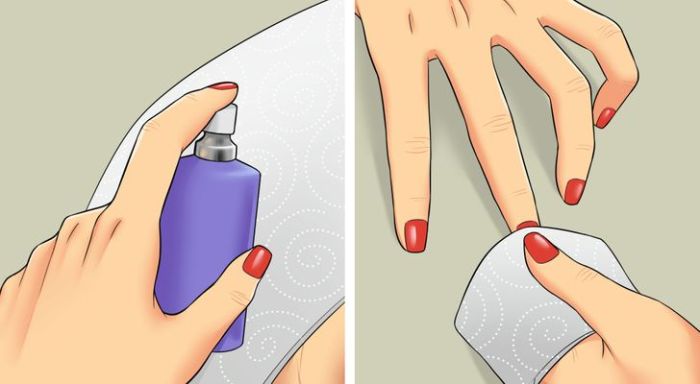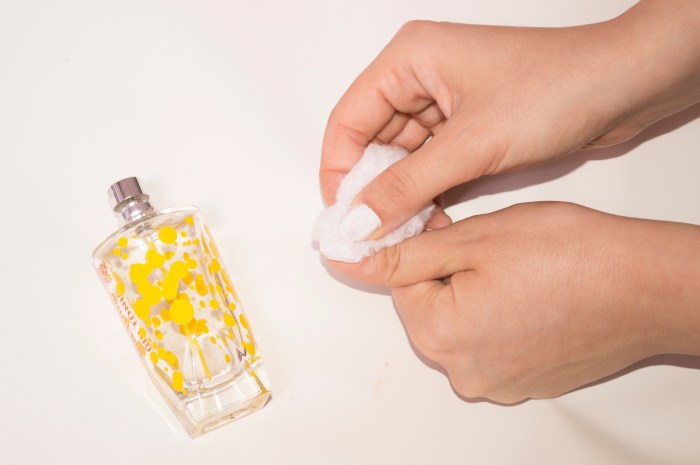Nail Polish Removing A Comprehensive Guide
Methods of Nail Polish Removal
Nail polish removing – Removing nail polish effectively and safely requires understanding the different methods and products available. The choice between acetone-based and acetone-free removers, for instance, significantly impacts both the removal process and the health of your nails. This section explores various techniques and their comparative advantages and disadvantages.
Acetone-Based vs. Acetone-Free Nail Polish Removers
Acetone-based removers are generally faster and more effective at dissolving nail polish, particularly long-lasting formulas like gel or shellac. Acetone, a strong solvent, quickly breaks down the polish’s chemical bonds. However, prolonged exposure can dry out and weaken nails, making them brittle and prone to breakage. Acetone-free removers, often using ethyl acetate or other less harsh solvents, are gentler on nails but may require more time and effort for complete removal, especially with stubborn polishes.
They are a better choice for individuals with sensitive nails or those who frequently remove polish.
Removing Nail Polish with Cotton Balls and Acetone

Source: tsp.li
This step-by-step guide Artikels the safe and efficient removal of nail polish using cotton balls and acetone.
- Gather your materials: acetone-based nail polish remover, cotton balls, and a bowl.
- Pour a small amount of remover into the bowl.
- Saturate a cotton ball with the remover.
- Hold the cotton ball against a nail for 10-15 seconds, allowing the acetone to soften the polish.
- Gently wipe the polish away, working from the cuticle to the tip of the nail. Repeat as needed.
- Repeat steps 3-5 for each nail.
- Wash your hands with soap and water to remove any remaining remover.
- Apply a moisturizing hand cream or cuticle oil.
Safety Precautions: Always work in a well-ventilated area to avoid inhaling acetone fumes. Avoid prolonged skin contact with acetone, as it can cause dryness and irritation. Keep acetone away from open flames and heat sources.
Comparison of Nail Polish Remover Types
| Type | Effectiveness | Cost | Convenience |
|---|---|---|---|
| Acetone-based liquid | High | Low to Moderate | Moderate |
| Acetone-free liquid | Moderate | Low to Moderate | Moderate |
| Remover wipes | Moderate to High (depending on formula) | Moderate to High | High |
| Remover pens | Low to Moderate (best for touch-ups) | Moderate to High | High |
Using Non-Acetone Removers
Non-acetone removers are a gentler alternative, particularly beneficial for individuals with sensitive skin or nails prone to dryness. Their effectiveness varies depending on the type of nail polish. While they work well on regular nail polish, they may require more time and effort for gel or long-lasting polishes, potentially requiring multiple applications or soaking.
Nail Polish Remover Ingredients and Their Effects

Source: wikihow.com
Understanding the ingredients in nail polish removers helps you make informed choices and minimize potential harm to your nails and skin. This section details common ingredients and their effects, as well as safer alternatives.
Key Ingredients and Their Functions
Most nail polish removers contain solvents like acetone or ethyl acetate to dissolve the polish. Other common ingredients include emollients to soften the skin, fragrances, and sometimes added moisturizers to counteract the drying effects of the solvent.
Negative Effects of Prolonged Exposure
Frequent or prolonged exposure to acetone can lead to dry, brittle, and cracked nails. It can also irritate the skin around the nails, causing redness, dryness, and even allergic reactions in some individuals. Other harsh chemicals in some removers may have similar effects.
Minimizing Nail Damage During Removal
To minimize nail damage, always use a gentle remover appropriate for your nail type. Avoid excessive scrubbing or harsh rubbing. Apply remover for a short period before wiping, allowing the polish to soften. Always follow up with a moisturizing hand cream or cuticle oil.
Natural Alternatives to Acetone
- Olive Oil: Its emollient properties help gently lift polish.
- Coconut Oil: Similar to olive oil, it helps soften and remove polish.
- White Vinegar: Its acidity can help dissolve some polishes.
Note: Natural alternatives are generally less effective than acetone-based removers and may require more time and effort.
Removing Different Types of Nail Polish
Different nail polish types require different removal techniques. Improper removal can damage the nail plate, so understanding the specific steps for each type is crucial. This section details safe and effective removal methods for regular, gel, and glitter nail polishes.
Removing Regular Nail Polish
Removing regular nail polish is generally straightforward. Start by applying a small amount of remover to a cotton ball and gently wipe the polish away, working from the cuticle towards the nail tip. For stubborn polish, hold the cotton ball on the nail for a few seconds to allow the remover to soften the polish before wiping.
Removing Gel Nail Polish
Gel nail polish removal requires more effort. It’s crucial to follow these steps carefully to avoid damaging your nails. First, carefully file the top layer of the gel polish to expose the base coat. Then, soak cotton pads saturated with pure acetone and place them on your nails, wrapping them with foil for 10-15 minutes. The gel should soften and lift away, but if not, repeat the soaking process.
Removing nail polish can be a simple process, but it’s crucial to use the right techniques, especially with longer-lasting options. For instance, if you’re dealing with the stubborn hold of a gel manicure, understanding the proper removal steps is key. Finding high-quality products like those offered by gel nail polish opi can make a difference in the overall ease and effectiveness of your nail polish removing routine, leading to healthier nails overall.
Always prioritize gentle removal to avoid damaging your nails.
Gently push off the softened gel with a cuticle pusher. Warning: Incorrect removal can cause significant damage to the nail plate, leading to thinning and weakening.
Comparison of Nail Polish Removal Methods
| Polish Type | Removal Method | Effectiveness | Potential Nail Damage |
|---|---|---|---|
| Regular | Acetone or acetone-free remover with cotton | High (acetone) to Moderate (acetone-free) | Low |
| Gel | Acetone soak and removal | High | High (if done incorrectly) |
| Acrylic | Filing and acetone soak | High | High (if done incorrectly) |
Removing Glitter Nail Polish
Glitter nail polish can be particularly challenging to remove due to the embedded glitter particles. Soaking the nails in acetone for a longer period (15-20 minutes) can help loosen the glitter. Gentle scraping with a wooden cuticle pusher, rather than aggressive scrubbing, is recommended to prevent nail damage.
Nail Care After Polish Removal
Post-polish removal care is essential to maintain healthy, strong nails. This section focuses on moisturizing techniques and the importance of allowing nails to “breathe” between manicures.
Moisturizing and Caring for Nails
After removing nail polish, always moisturize your nails and cuticles to prevent dryness and brittleness. Apply a rich hand cream or cuticle oil to hydrate and nourish the nail bed and surrounding skin.
Benefits of Cuticle Oil and Hand Cream
Cuticle oil helps keep the cuticles soft and supple, preventing hangnails and dryness. Hand cream provides overall hydration and protection for the skin, improving its elasticity and resilience.
Proper Nail Care Post-Removal (Infographic Description)
Step 1: Gently push back cuticles with a cuticle pusher. Step 2: Apply cuticle oil to hydrate the cuticles. Step 3: Massage hand cream into hands and nails. Step 4: Avoid harsh chemicals and excessive water exposure. Step 5: Allow nails to breathe between manicures.
Importance of Allowing Nails to Breathe, Nail polish removing
Frequent polish application can weaken and dehydrate nails. Allowing your nails to go polish-free for a period between manicures gives them a chance to recover and strengthen, preventing damage and promoting healthy growth.
Tools and Techniques for Efficient Removal: Nail Polish Removing
Efficient nail polish removal involves selecting the right tools and employing techniques that minimize waste and maximize effectiveness. This section explores various techniques and tools, promoting both efficiency and environmental consciousness.
Techniques for Applying Nail Polish Remover
To minimize waste, saturate cotton balls only as needed, and avoid using excessive amounts of remover. Work methodically, ensuring complete coverage of the nail surface to avoid re-application.
Recommended Tools for Nail Polish Removal
- Cotton balls or reusable cotton rounds
- Cuticle pusher (wooden or metal)
- Nail polish remover (acetone or acetone-free)
- Hand cream or cuticle oil
Advantages and Disadvantages of Different Cotton Types
Regular cotton balls are inexpensive and readily available, but they create more waste. Reusable cotton rounds are a more sustainable option, reducing environmental impact, but require washing and replacing periodically.
Tips for Efficient and Environmentally Friendly Removal
- Use reusable cotton rounds to reduce waste.
- Avoid excessive use of nail polish remover.
- Choose remover bottles with pumps or pour spouts to prevent spills.
- Recycle used cotton rounds and bottles appropriately.
FAQs
Can I use nail polish remover on artificial nails?
Artificial nails require specific removal methods. Using regular nail polish remover may damage them. Consult a professional or follow instructions for the specific type of artificial nail.
How often should I remove my nail polish?
Allowing your nails to “breathe” between manicures is beneficial. The frequency depends on personal preference, but allowing a few days or a week between applications is generally recommended.
What can I do if nail polish remover dries out my nails?
Use a rich cuticle oil and hand cream regularly after removing nail polish to hydrate and nourish your nails, preventing dryness and brittleness.
Are there any environmentally friendly nail polish removers?
Yes, many brands offer acetone-free removers or those made with natural ingredients. Look for removers in recyclable containers.





















